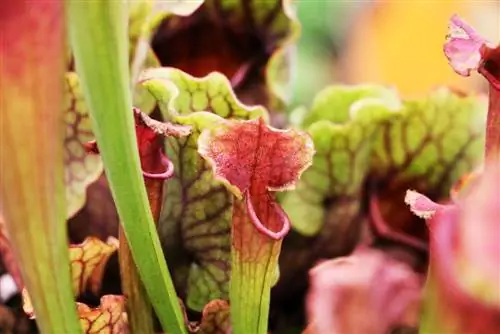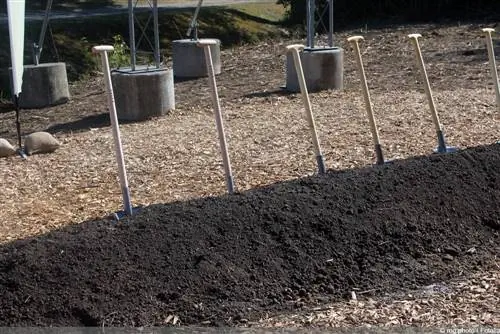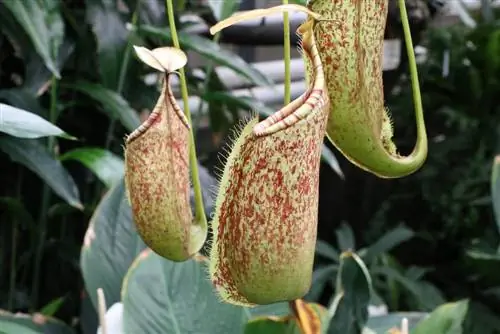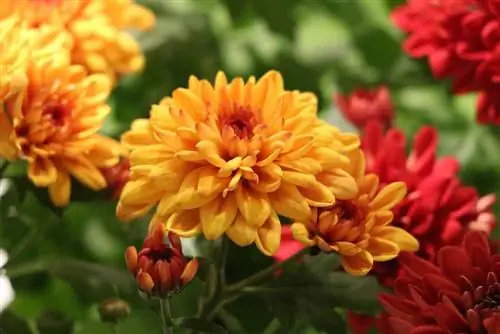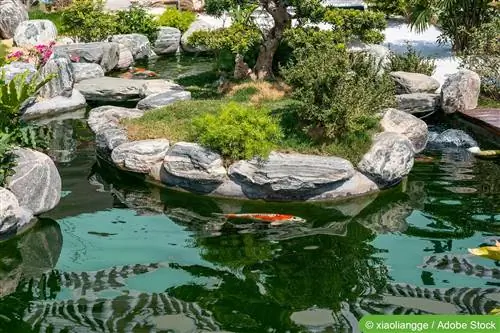- Author admin [email protected].
- Public 2023-12-17 03:39.
- Last modified 2025-06-01 06:48.
Pitch plants are carnivores (meat-eating plants). They are also known as the trumpet plant. The eight species differ in shape and color. Some species of this perennial plant are hardy, others only partially or not at all. Pitcher plants score points with their brightly colored tubes, which serve as traps. Some species have a lid-like curvature and others are open at the top. They can grow up to 75 cm high and 30 cm wide.
Care for Pitcher Plants
Sarracenia are easy plants to cultivate if basic things are taken into account. They require plenty of sun, water and rest during the winter months. In addition, the extraordinary plant does not need to be fertilized or fed.
Site conditions
Lots of light and sun, that's how the Sarracenia feels comfortable. Then the cardinal points don’t play a big role.
- Temperatures between 20 and 25 °C are ideal
- Outdoor specimens can also tolerate higher temperatures
- light shading at exceptionally high temperatures
Soil conditions
It would be optimal if the plant was cultivated in a peat bed. Pure peat or a mixture of peat and sand is suitable as a substrate. The first choice here should be white peat and quartz sand (ratio 2:1). Quartz sand is used to loosen the peat.
Tip:
Do not use sea sand. This contains too much lime and s alt and would destroy the plant.
Pouring
Carnivorous plants love it moist. If wet feet have to be avoided with other plants, waterlogging is a decisive criterion for the growth of trumpet plants.
- high water requirement
- pouring using the damming method
- Coaster should always be filled with one to two centimeters of water
- Waterlogging is necessary
Tip:
If the plant is in danger of drying out, it can be placed in a container of water until no more air bubbles can be seen. It is then placed horizontally for an hour.
Watering
Unknowingly, many hobby gardeners make the most mistakes here. You water with tap water. However, due to the lime content, this can be fatal for the exotic creatures. Water from the dryer is also not necessarily recommended. This may contain residues of fabric softener or detergent as well as lint.
- soft, lime-free water
- best to use rainwater
- as an alternative, distilled water (mix with ten percent tap water)
Propagate
Reproduction by division
- Plant has a strong rhizome with several vegetation points
- Carefully cut these off with a knife if there are roots
- Treat fractures and interfaces with charcoal powder to prevent molding
- plant as usual
Propagation from seeds
- Cold treatment required before sowing
- put the seeds in the refrigerator for about four to six weeks
- then place on appropriate substrate, do not cover
- Keep substrate moist
- Sowing indoors possible all year round
The young plants do not need hibernation for the first few years.
Wintering
Among pitcher plants, there are species that are quite frost-resistant and those that cannot tolerate any frost. Hardy species should be covered with leaves during the cold season. Sarracenias in containers and pots are generally at risk of frost and should be moved to winter quarters.
- Winter bright and cool
- optimal temperature between five and ten degrees Celsius
- water little
- Don't let the substrate dry out, but keep it evenly moist
Tip:
If the winter place is too dark and too moist, gray mold can easily develop, which can lead to the loss of the plant.
Diseases and pests
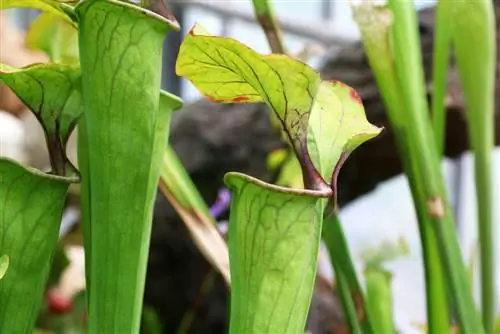
Anyone who keeps their child too warm or too cold in winter, exposes them to excessive humidity or does not ventilate well must expect gray mold. Gray mold often occurs when the winter place is too dark, too wet and not ventilated. This hairy fur covers the rhizome and literally eats it up. Treatment can include cutting off the affected area and treating it with a fungicidal agent. The main pests are aphids and scale insects. Commercially available pesticides can be used here. Sometimes snails also mess with the plant. In this case, slug pellets can help.
Frequently asked questions
The hoses will turn brown at the top. Cut it or wait?
With Sarracenia, it is completely normal for the old tubes to die. If new leaves grow, this is no cause for concern. To avoid mold, the rotten leaves of houseplants should be removed immediately.
Can a pitcher plant become clogged if there are too many insects in the hose?
No need to worry. In summer it often happens that the hoses are full to the brim with insects. After digestion, the prey remains in the tube until it dies.
Tips for speed readers
- Pitch plant is one of the carnivorous plants
- can be cultivated outdoors and indoors
- Location: bright, full sun
- ideal is 20 to 25 °C
- Shading options in extreme temperatures
- prefers acidic soil
- Substrate: pure peat or mixture of white peat and quartz sand
- high water requirement
- pour using the damming method
- Coaster should always be filled with water
- no tap water
- better rainwater or distilled water
- Propagation possible by division or seeds
- Winter bright and cool at five to ten degrees
- Keep substrate evenly moist and not too wet
- Always pay attention to proper care to prevent diseases and pests
What you should know about the pitcher plant in brief
The decorative, very exotic pitcher plants are among the animal-catching plants. Their long leaves form towering tubes with a trumpet to funnel-shaped end. They are arched over by a lid-like structure. These and the upper tube area are conspicuously colored and marked, and they also produce nectar. This attracts insects into the tube. Here they slowly slide down into a digesting liquid. Large hanging flowers, each with five green to red sepals and yellow to red petals, appear singly at the top of tall stems. In total, there are eight species of pitcher plant that are slightly mixed with each other and are native to Florida to Canada. They need the cool, moist environment of a winter garden, but can also be brought into the house at short notice.
Popular types of pitcher plants
- Sarracenia flava grows to a height of 30 - 60cm. Upright, slender, yellow-green leaves form a trumpet-shaped calyx with a red throat. The 7.5 - 10cm wide flowers are yellow and in some varieties yellow and brown.
- Sarracenia leucophylla, 30 - 75cm tall, produces green leaves that open into white trumpets with striking, deep purple marbling. The 5 - 7.5cm wide flowers are yellow to purple-red.
- Sarracenia psittacina has semi-erect, 10 - 20cm high leaves in green to purple. The upper calyx is bloated and ends in a pointed beak with white spots and purple veining. The deep red flowers are 5cm wide and grow on 20cm high, upright stems.
- Sarracenia purpurea produces semi-erect, green leaves about 15cm long, which form a calyx and have crimson, wavy edges and a crimson veining in the throat. The 6cm wide, deep purple flowers crown the 30cm high stems.
- Sarracenia rubra forms a 15 to 30cm high rosette of cup-shaped leaves. Initially they are olive green, but later take on a copper tone and show noticeable brown veins as they age. The flowers are up to 4.5cm wide and bronze red.

